We probably should add an FAQ page to this blog, because we tend to get the same questions over and over:
- How do you like New Zealand?
- What do Church History Missionaries do?
- Can you really go anywhere you want without having to wear a mask?
We’ve already provided answers to many of those FAQs in previous blog posts, but there is one question that has come up constantly during the month of December that we have not yet addressed:
- How does it feel to be spending Christmas in New Zealand?
The short answer is: Fine. We are happy to be here—especially considering that if we were in the U.S., we would not be spending Christmas with our family and friends anyway. We have no interest in either spreading or contracting COVID.
But most people who have asked this question, or some variation of it, probably want more than the short answer. They want to know what makes Christmas in New Zealand different from Christmas in America. Here are our observations:
The most obvious difference is that because New Zealand is in the Southern Hemisphere, Christmas occurs in the summertime.
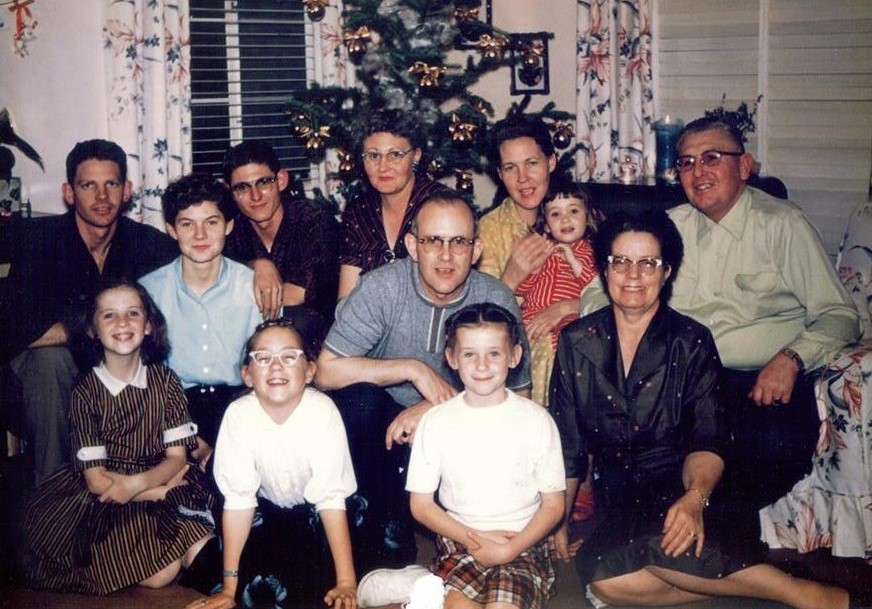
Nancy with her parents, sisters, aunts, uncle and cousins, Christmas 1957. She’s the little one in red on her mom’s lap
Having grown up in Southern California, Nancy was accustomed to wearing short sleeves and maybe even sandals throughout the Christmas season, until she got married and began spending most Christmases in colder climes. As a child, she could count on going outside after the gifts were unwrapped on Christmas Day so she could try out the roller skates Santa had brought, or help her dad attach the new elongated seat and high-rise handlebars that would transform her old, ordinary bike into a stylish “Sting-Ray.”
So it was not snow in the yard or icicles hanging from the roof that set Christmastime apart from all other seasons and made it magical for Nancy; rather, it was that when the sun went down about 5:00 p.m., the Christmas lights would come on.
During the 1960s, the roofline of nearly every house in Nancy’s community was strung with multicolored, flame-shaped bulbs that suburban dads had dutifully put up as soon after Thanksgiving as they could get to it, after they were done mowing the lawn. There were lights on the Christmas tree, too, and Nancy could hardly wait for the sun to go down so she could plug them in. One of her family’s favorite Christmastime activities was driving around town just before bedtime—after the kids had put on their pajamas and brushed their teeth—to see the colored lights and illuminated yard displays. Sometimes, the family would get together with friends and go caroling in the evening. Southern California cools off after the sun goes down, so walking around the neighborhood after dark provided justification for wearing wooly sweaters and maybe even knitted caps and gloves, although there was little chance of Jack Frost nipping at one’s nose.
In contrast, Michael experienced plenty of cold, snowy Christmases during his youth in Idaho, but he was similarly enchanted by Christmas lights. Even as an adult, one of Michael’s favorite holiday traditions is sitting quietly in a darkened room before an illuminated Christmas tree, allowing the twinkling lights to evoke fond memories and reflections on the birth of Jesus Christ.
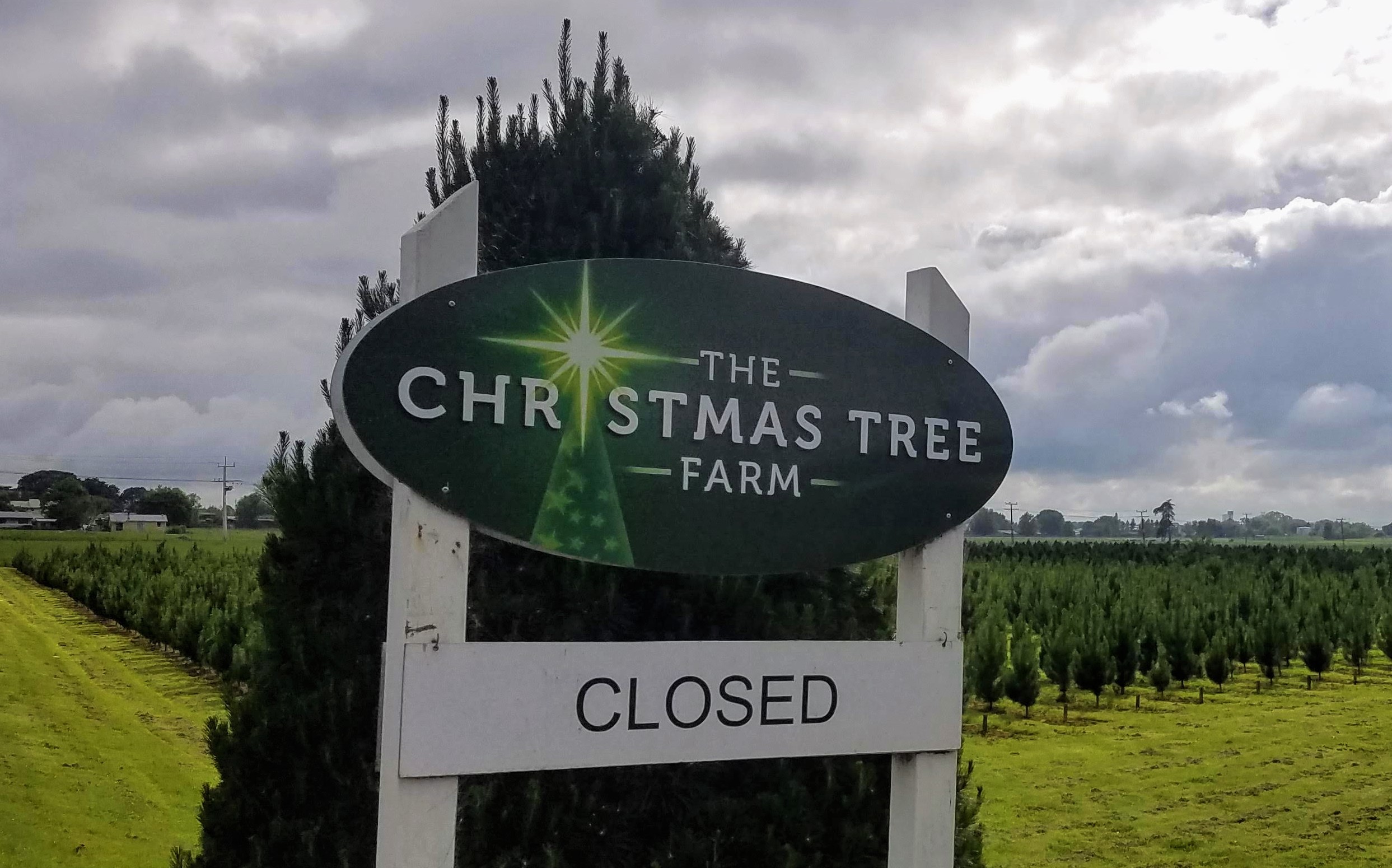
We pass this establishment every day on the way to work. During December, the sign finally changed to “Open”
The fact that in New Zealand, Christmas occurs just days after the Summer Solstice means that darkness does not fall until about 9:30 p.m., when it’s time for little children and missionaries to be at home getting ready for bed. The whole concept of Christmas lights thus falls flat. Why bother to string lights along your roof when no one can tell whether they’re plugged in? Is there really a need to #LighttheWorld when the world (as we see it) is ablaze with sunshine sixteen hours a day?
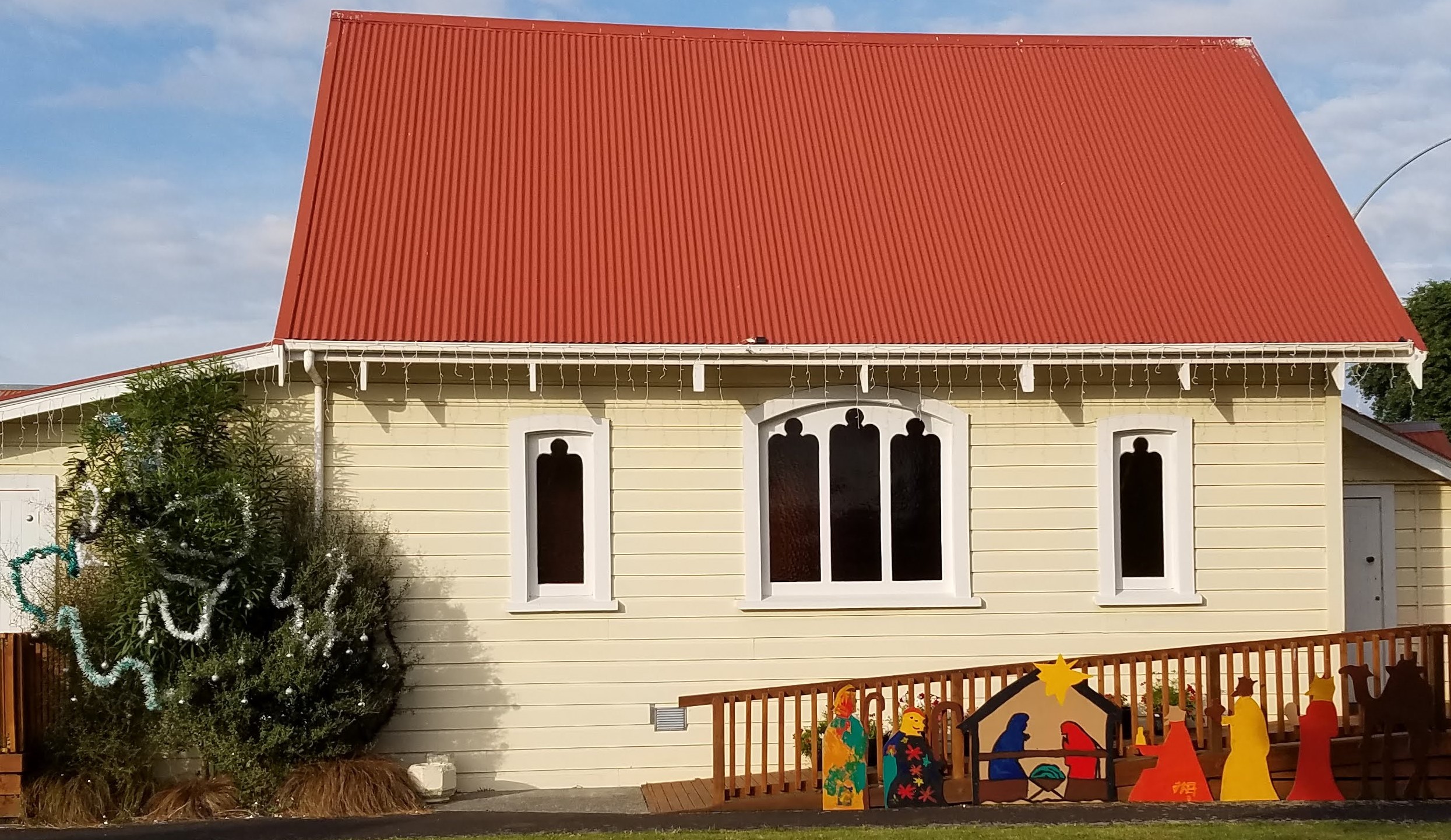
The Christian church/Māori marae across the street from our flat, decorated for the season
Thus decorating the outside of one’s home for the holidays is not as common here as it is in the States. Some people do, in fact, put up lights, but it’s more typical to see Santa lawn ornaments and inflatable snowmen, or red and white signposts with a holiday greeting. New Zealand’s Christmas conventions must owe more to American influence than to British, because Kiwis always say “Merry Christmas” instead of “Happy Christmas” as we had expected. Or they may say “Meri Kirihimete,” which is simply the Māori-ized form of the phrase: the way one must pronounce “Merry Christmas” in a language that utilizes no consonant blends and no sibilants.
Our favorite New Zealand holiday decorations are the ones Nature provides:
- Star jasmine’s scent is powerful and even more intoxicating than pumpkin spice
- Canna lilies make the season bright
- Perfectly shaped Norfolk Island pines are common in New Zealand and make it seem like Christmas all year long
- Some hydrangeas in our neighborhood might be more appropriate for Hanukkah than Christmas
- Puhutakawa trees decorate themselves for Christmas
- Christmas roses
- A garland of brilliant bougainvillea
One afternoon early in November, Eva had walked over to Nancy’s desk and said, “We need to talk. Do you have time now, or should I come back later?” Sensing the seriousness in Eva’s tone, Nancy replied, “Give me ten minutes”—and then couldn’t concentrate on finishing the immediate task, having suddenly become preoccupied with trying to imagine what concern was weighing so ponderously on Eva’s mind.
Ten minutes later, Eva looked earnestly into Nancy’s eyes and said, “There’s a lot on the calendar for the rest of this month, so we need to decide now how we’re going to decorate for Christmas.” Nancy was so relieved, she almost burst out laughing.
In previous years, Eva explained, the Mendenhall Building (site of the Hamilton Mission offices, the Church Distribution Centre, and some other entities in addition to the Matthew Cowley Pacific Church History Centre) had been decorated by the committee that planned Temple View’s annual Christmas light display and concert series. This year, however, with the temple closed, there would be no light display and no concert series, so if anyone was going to decorate the MCPCHC, it would have to be us.
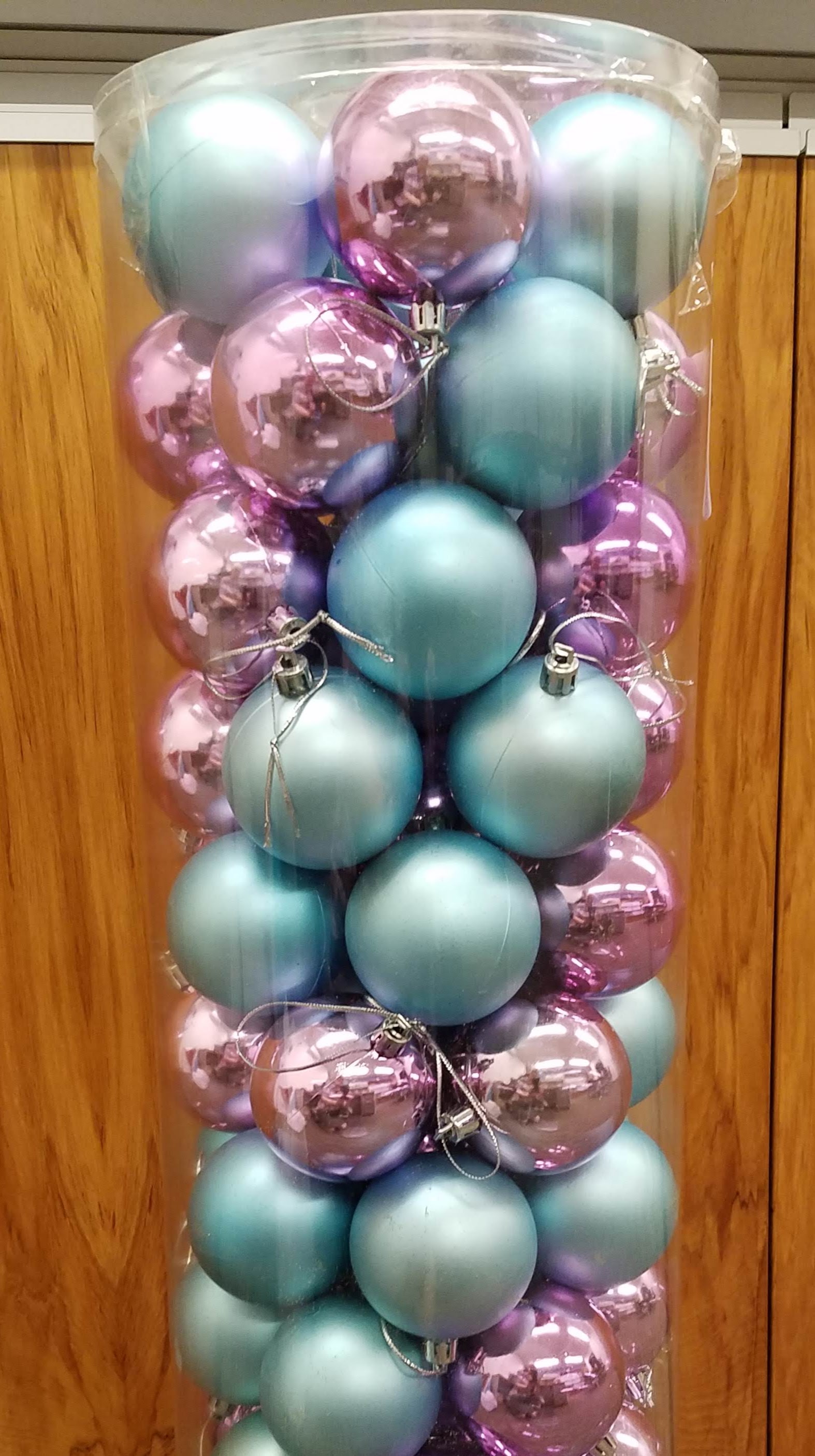
The pastel baubles are destined for the Op Shop
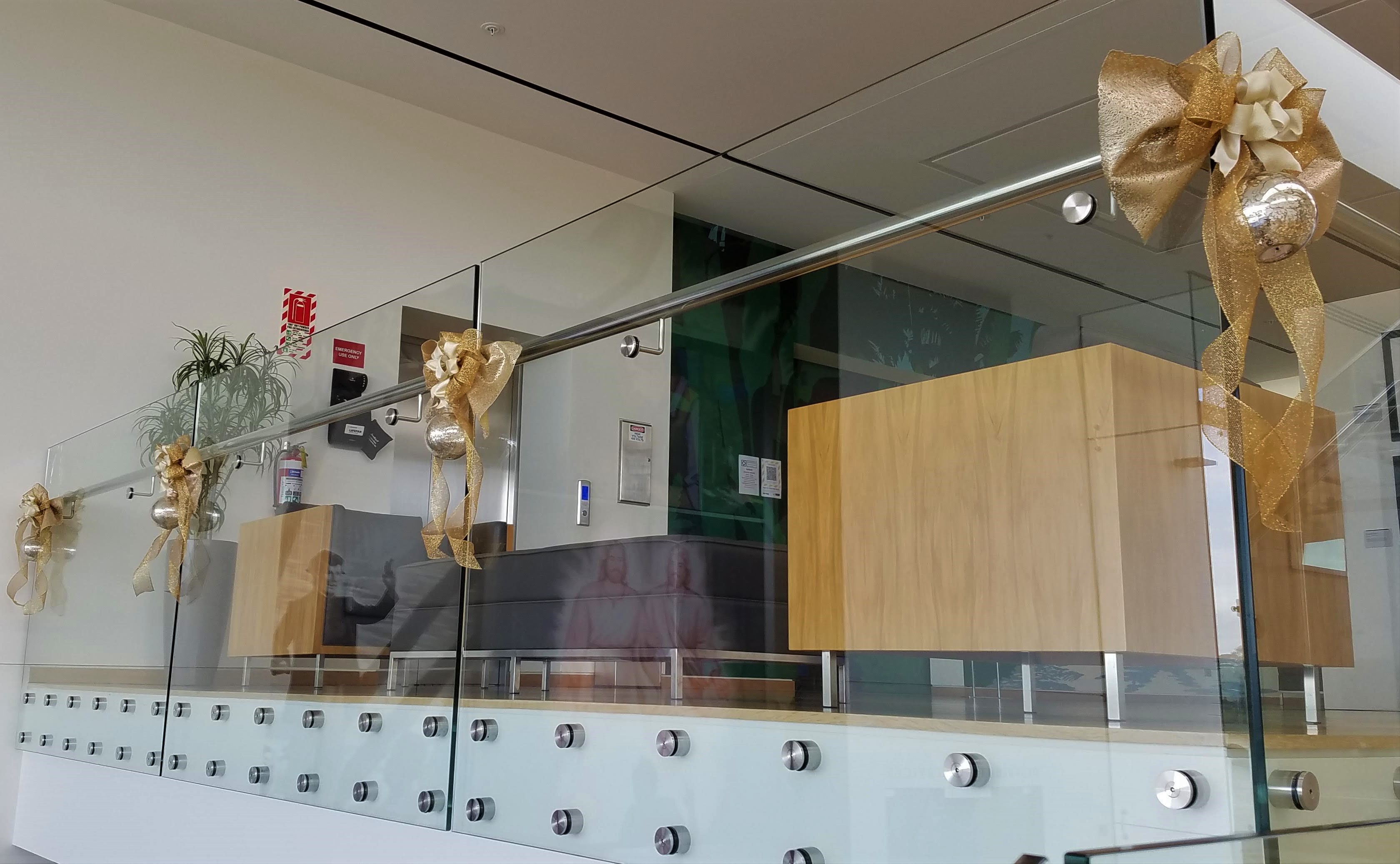
Ornamented gallery
Nancy and Eva thus spent the next hour or so assessing the contents of the cabinet where the Centre’s small cache of Christmas decorations was stored. There was an artificial Christmas tree, a couple of strings of tiny LED lights (which, when plugged in, worked, praise the Lord!), a box of star-shaped metallic tree ornaments, two big plastic sleeves filled with sparkly “baubles” in pastel hues, two gold tinsel garlands, and another box containing two rolls of wide gold ribbon, six gold filigree placemats, and six large, gold-tinged glass globes.
Eva knew just what to do with the ribbon and placemats because she was the one who had wired them together with the glass globes last year, creating attractive ornaments to complement the Centre’s gleaming glass balcony and stair rail. She also knew just what to do with the tinsel garland: leave it in the cabinet. (Tinsel didn’t meet her standard of elegance, and elegant was the look she was aiming for.) The pink and blue baubles didn’t make the cut, either, but Eva and Nancy determined that there were probably enough gold and copper-colored balls to adequately cover the tree when combined with the similarly hued star ornaments.
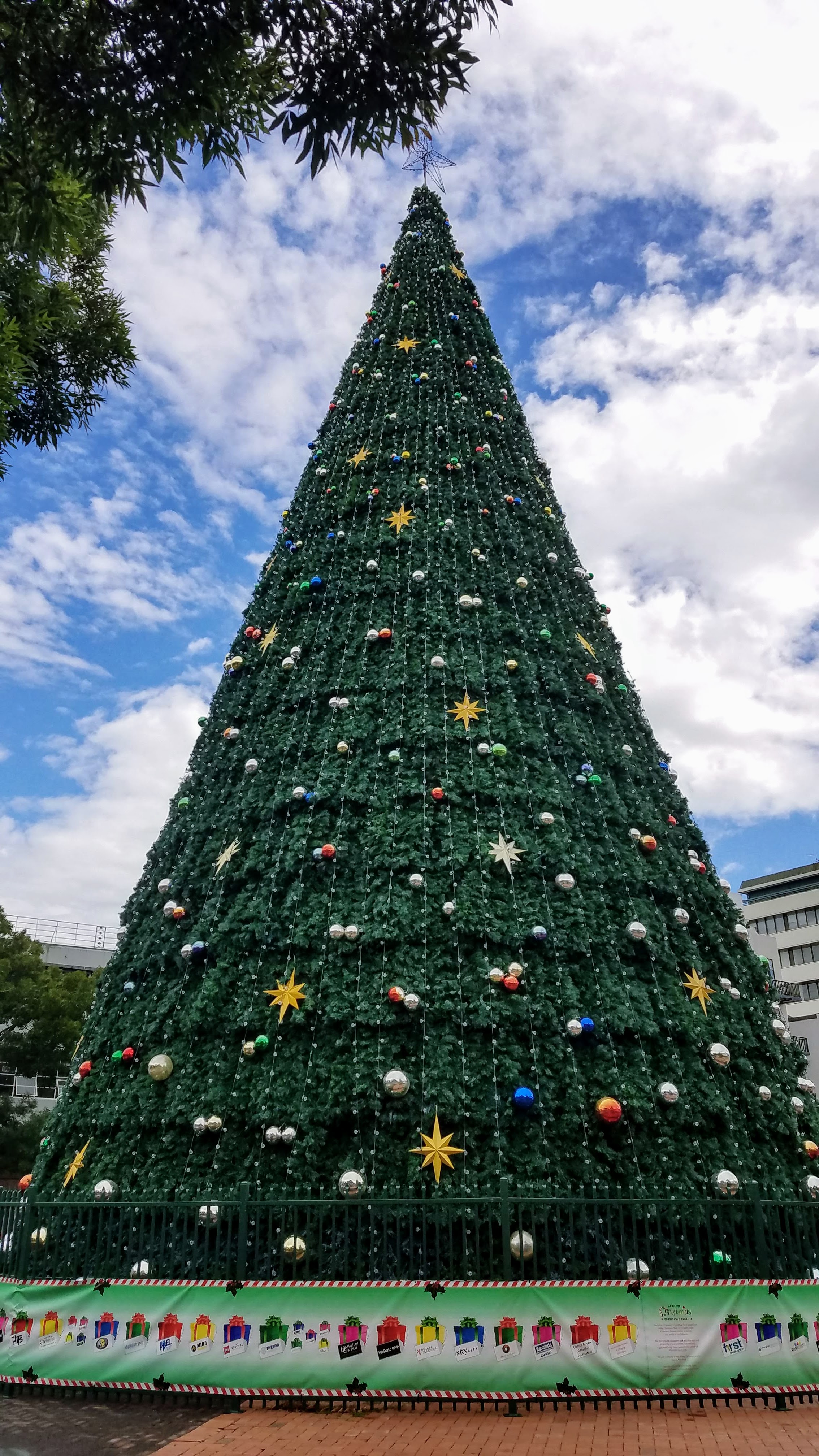
The tree in Hamilton’s Garden Place is 27 metres high–the tallest in New Zealand
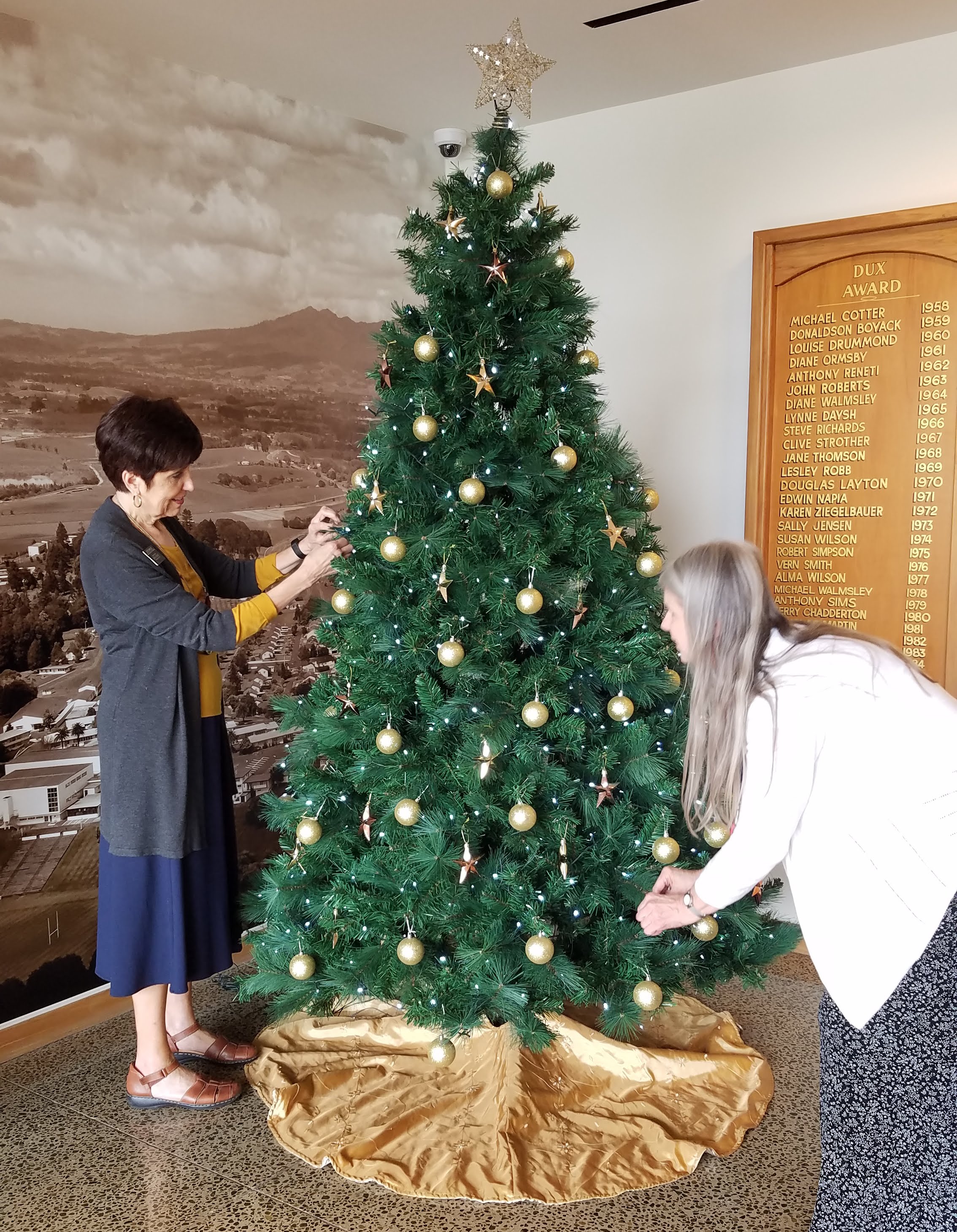
Eva and Wendy decorating the tree
Once the inventory was taken, Eva sent Nancy and Michael to David’s Emporium (Hamilton’s equivalent of Cappel’s in Cincinnati, except larger and messier) to get some floral wire and supplement the Centre’s supply of ribbon so she could reassemble the big gold bows for the balcony ornaments. During the last week of November, Barry and Vic set up the Christmas tree; Michael rearranged all the branches so that it looked less like it had spent the year smashed into a cardboard box, and then the ladies did their best to make the tree and the rest of the Mendenhall Building look elegantly festive.
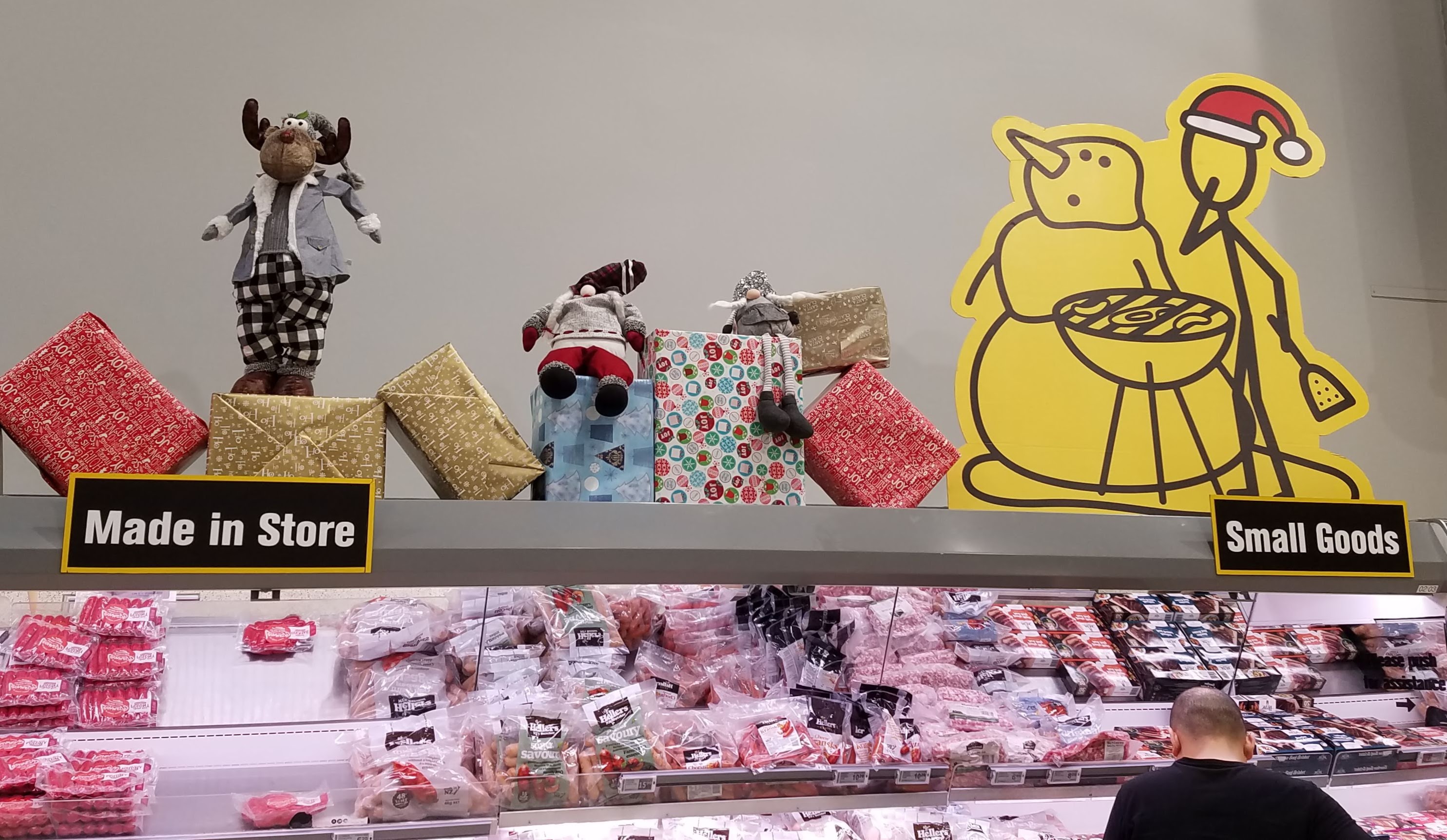
Summertime holiday decor at Pak ’n Save
Stores around Hamilton were doing likewise, although most were not as concerned as Eva about achieving elegance. Huge Christmas trees went up at The Base, Hamilton’s largest shopping mall, and at Garden Place in the Central Business District. Most stores displayed special Christmas merchandise, but few altered their background-music playlists to include Christmas songs. Pak ’n Save did offer grocery shoppers a soundtrack that included a particularly obnoxious version of “Jingle Bells,” in which a nasal, slightly off-key male voice intoned “Pak ’n Save, Pak ’n Save, Pak ’n Pak ‘n Save” through the entire melody. (We could hardly wait to check out and escape.) The absence of holiday music in most other stores spared us of endless repetitions of “Santa Baby” and “All I Want for Christmas Is You,” but we were left wondering whether New Zealand has any Christmas songs that reflect its Southern-Hemisphere Christmas traditions.
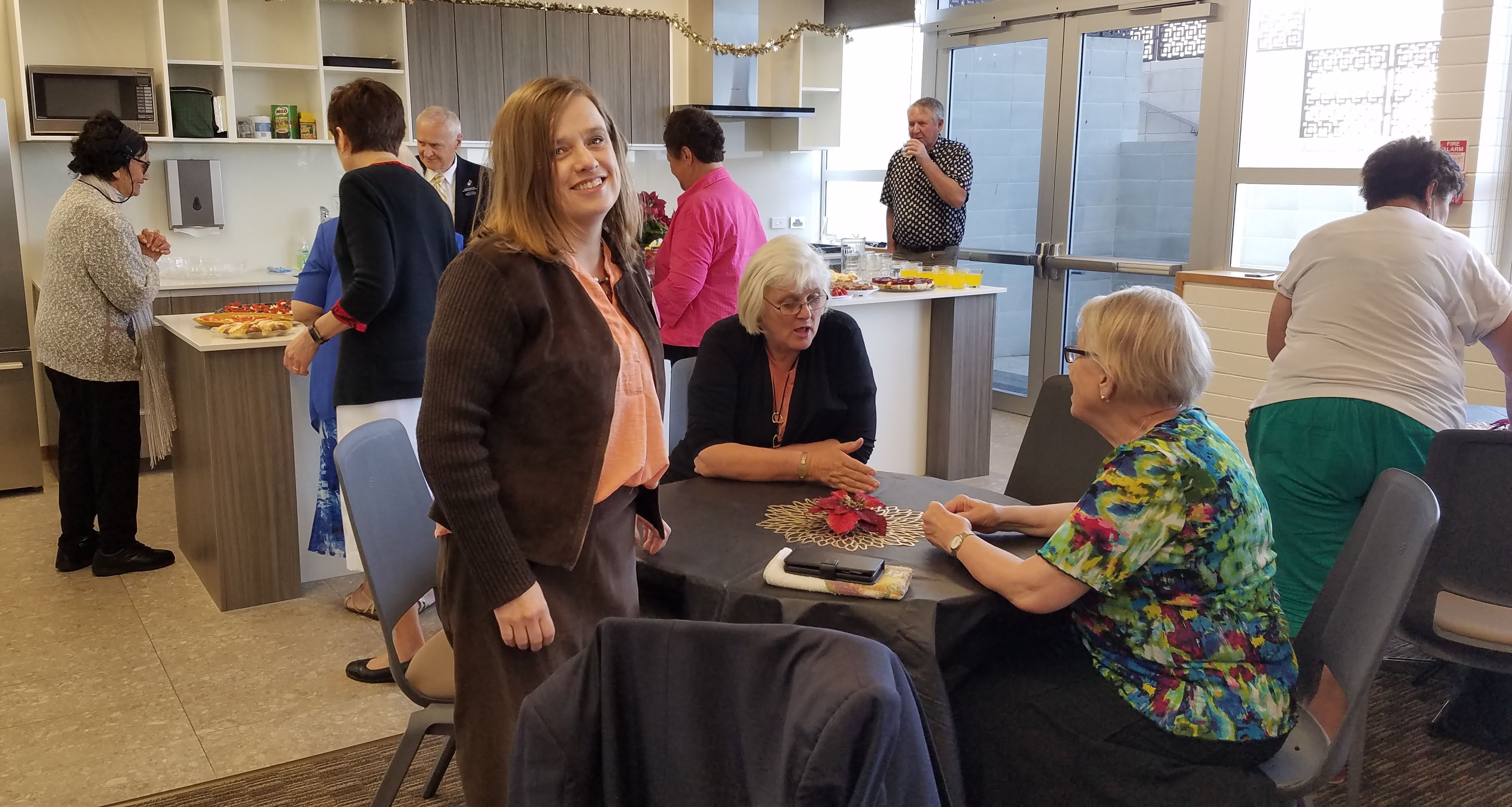
Museum Volunteers Christmas Social
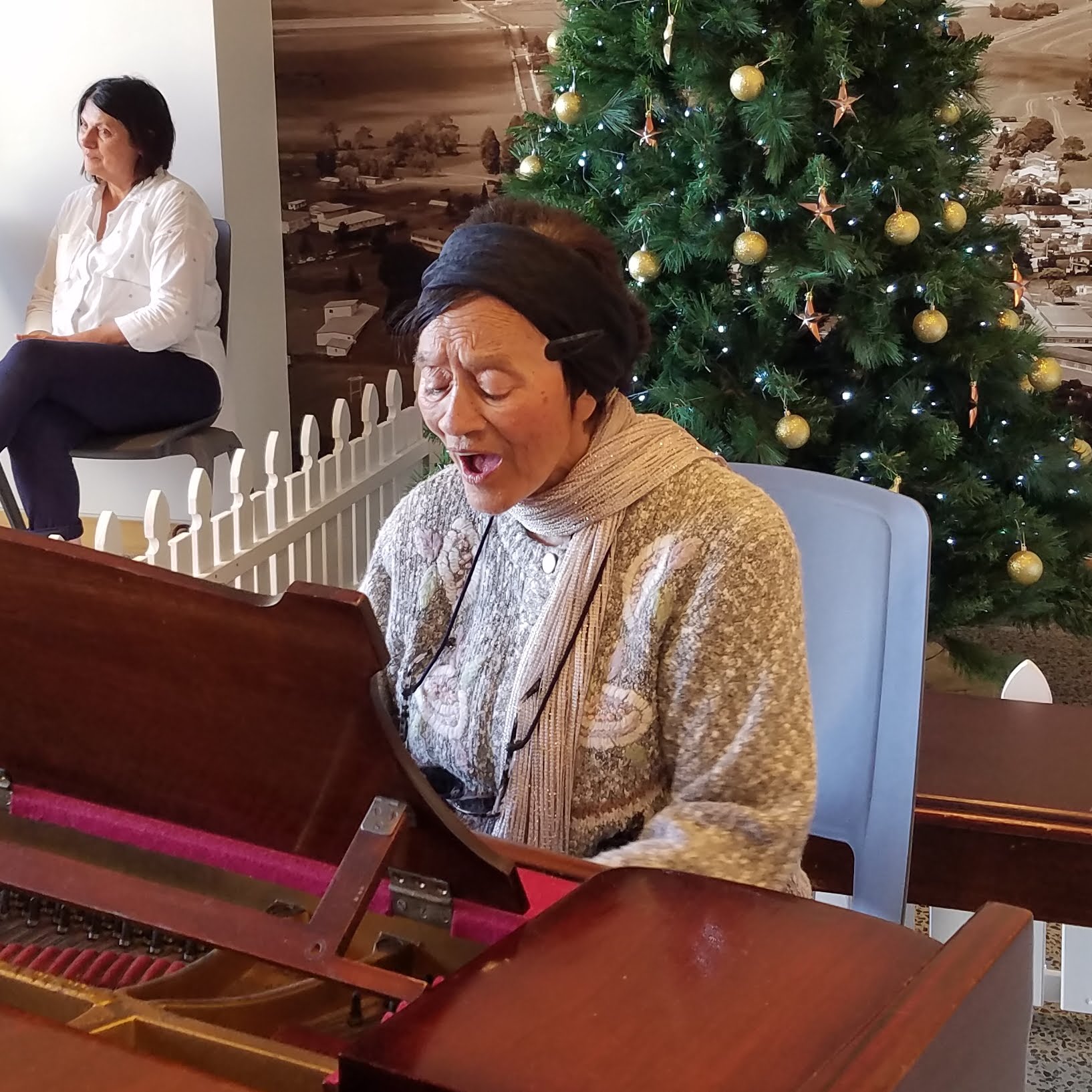
Shirley F accompanied a sing-along at the social for museum volunteers. She taught music at the Church College of New Zealand during the 1960s and 70s, so whenever she comes to the Centre to play, we joke that she’s part of the CCNZ exhibit
The holiday sing-along at a Christmas party the MCPCHC staff hosted for our museum volunteers featured only one song we’d never heard before, and a lot of others that left us feeling puzzled. Why do Kiwis all know the words to “Jingle Bells” and “Winter Wonderland” when both songs center on snow and sleighs and have absolutely nothing to do with Christmas? Why do they so enthusiastically sing “I’m Dreaming of a White Christmas” when few of them have ever known a Christmas with snow?

Pukeko in a ponga tree
Museum volunteers and ward members have shared a few Kiwi Christmas classics with us. One is a version of “The Twelve Days of Christmas” featuring a pukeko in a ponga tree instead of the partridge in a pear. [insert photos of pukeko and tree fern] Another is called “Christmas in New Zealand.” And then there’s the amusing version of “Walkin’ in a Winter Wonderland” called “Strollin’ Through a Summer Wonderland” that was featured in an Air New Zealand ad a few years ago. But mostly, Kiwis sing the same Christmas songs Americans do—the most popular ones, anyway—and no one seems to care about the seasonal incongruities.
As you certainly are aware, music is an essential part of our personal lives—the major cord that drew Michael and Nancy together as teenagers and keeps us living harmoniously after more than 43 years. This year, music became the key to making our December in New Zealand feel like Christmas. Early in the month, Nancy created a Spotify playlist with as many items from the eclectic Christmas CD collection we left in Cincinnati as she could find: the Dale Warland Singers, Chanticleer, the Cambridge Singers under John Rutter, George Shearing, Dave Brubeck, Mannheim Steamroller, Over-the-Rhine, Pentatonix; Nightnoise, Liz Story, Jim Brickman, and other Windham Hill artists … not the kind of holiday music one expects to hear issuing from store speakers. There may have been no decorated tree in our missionary flat, no fireplace hung with red-and-green stockings, and no electric candles in our windows, but we had familiar Christmas music, and that made all the difference.
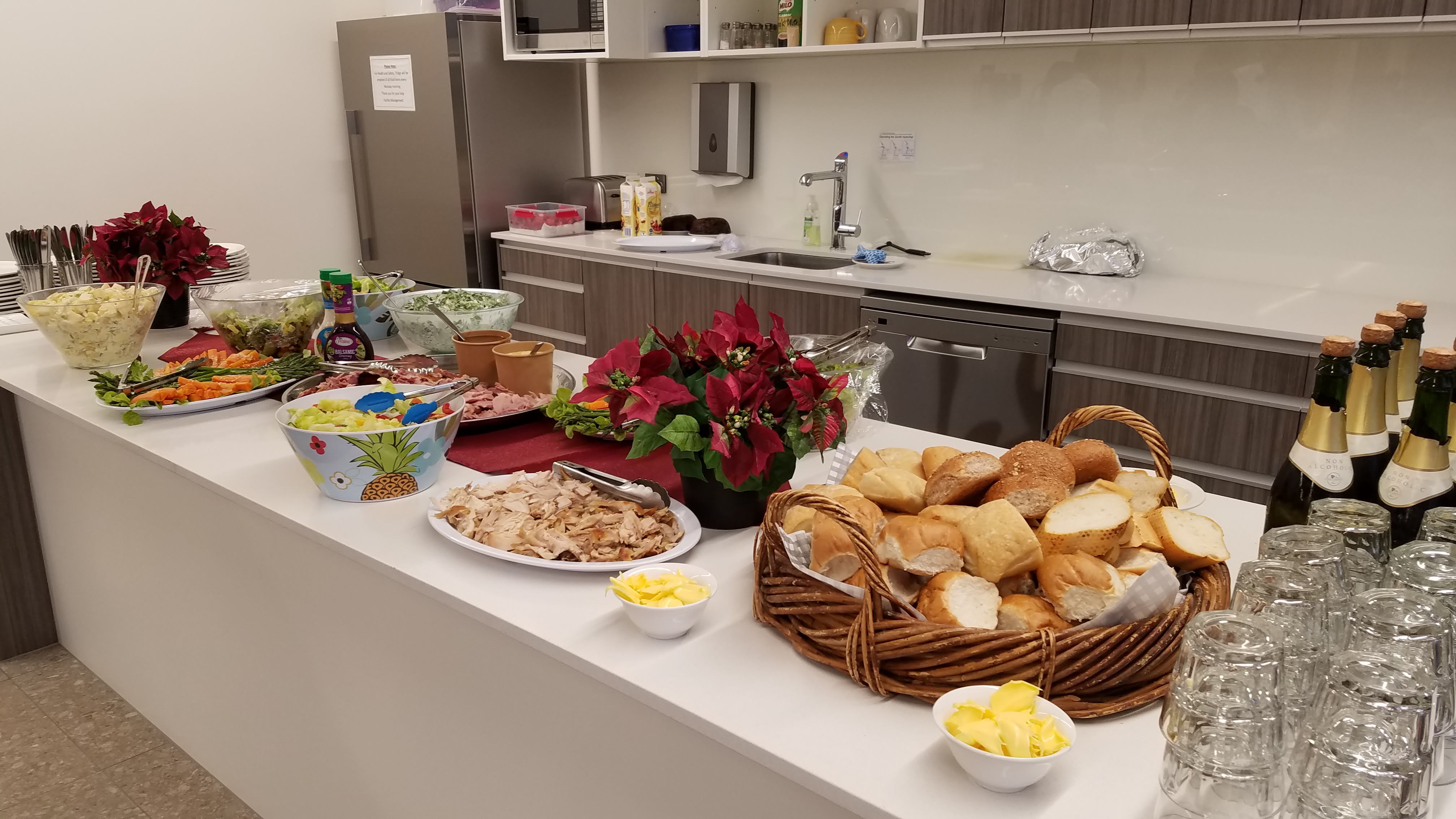
Holiday spread for all those who work in the Mendenhall Library building

Diane and Wendy each took turns stirring the fudge
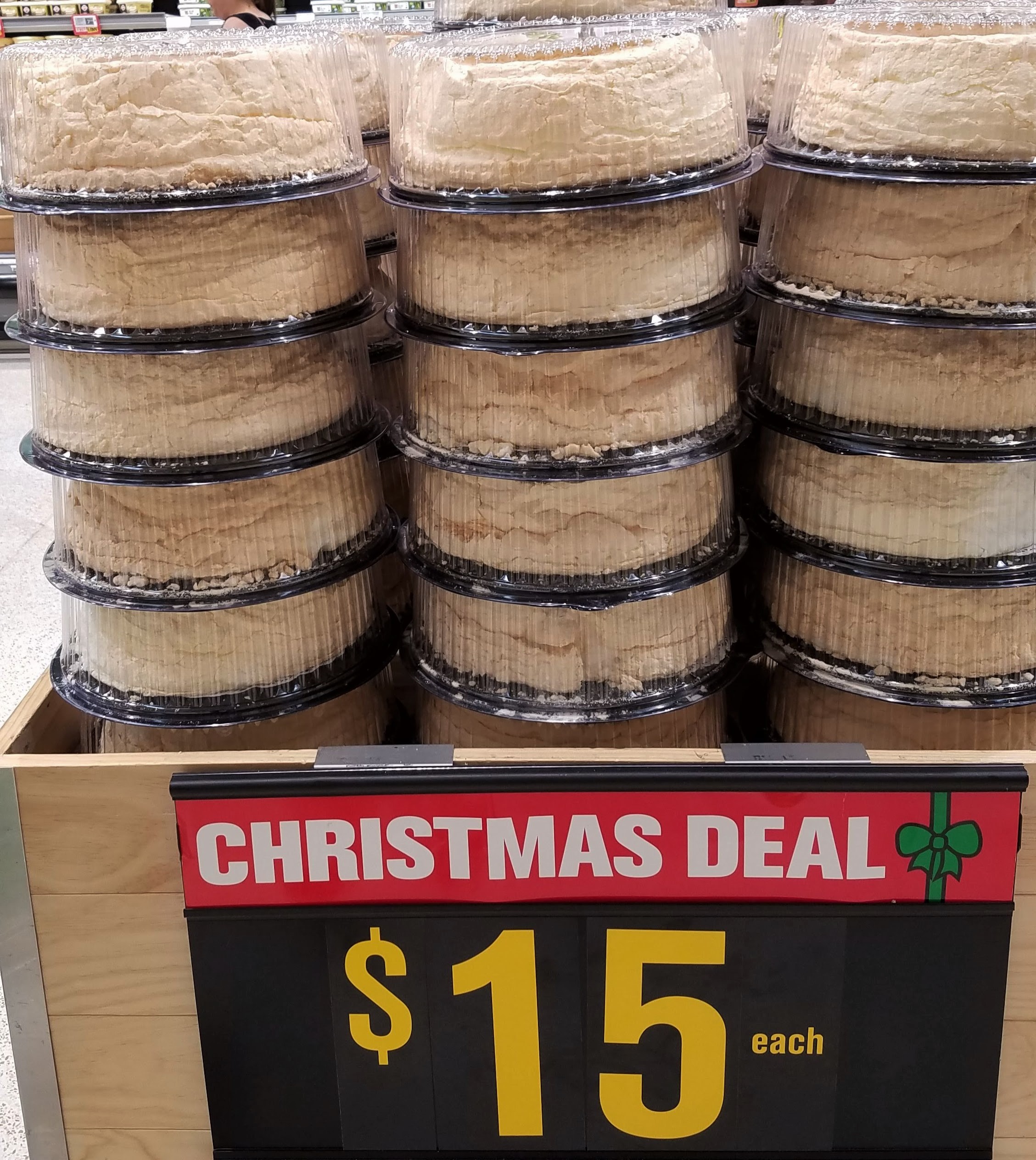
A stack of pre-baked “pavs” on special at Pak ’n Save. If most ovens in New Zealand have as much trouble maintaining a consistent temperature as ours, we can understand why few Kiwis attempt to make their own meringue base for this favorite dessert
On Wednesday 9 December we attended a party for everybody who regularly works in the Mendenhall Building (about thirty people). Paula S, manager of the Church Distribution Centre, had made assignments to each organization: Facilities Management brought drinks and bread, Hamilton Mission office personnel supplied salads, Distribution Centre employees brought desserts, and the MCPCHC missionaries provided the main dish. Barry decided that to make things easy, he’d order a sliced ham and a couple of roast chickens from the Temple View dairy (remember, a “dairy” is equivalent to a convenience store); Eva and Nancy then garnished the meat platter with lightly steamed asparagus spears and honey-glazed carrots. Other standouts on the serving table were a balsamic-mint couscous salad and a divine berry pavlova. After dinner, everyone took a few minutes to share a favorite holiday tradition. Michael explained how making fudge had become a must-do in our household every December—and then had to organize a fudge-making party in the Mendenhall Building lunchroom a few days later.
The following Saturday, we went over to the church for the Dinsdale Ward Christmas party, arriving right at 6:30, when the dinner and festivities were scheduled to begin. To our dismay, we could see only one car in the parking lot, but as soon as we entered the building we were met by a squealing pack of little kids who were running the circuit around the halls, so we knew we were in the right place. A few adults were in the gym, setting up chairs and throwing plastic covers over the banquet tables. Through the open doors at the back of the church, we could see plenty of cars parked behind the building, and people congregating near a row of smoking gas grills. The sound of sizzling and a tantalizing aroma filled the summer air.
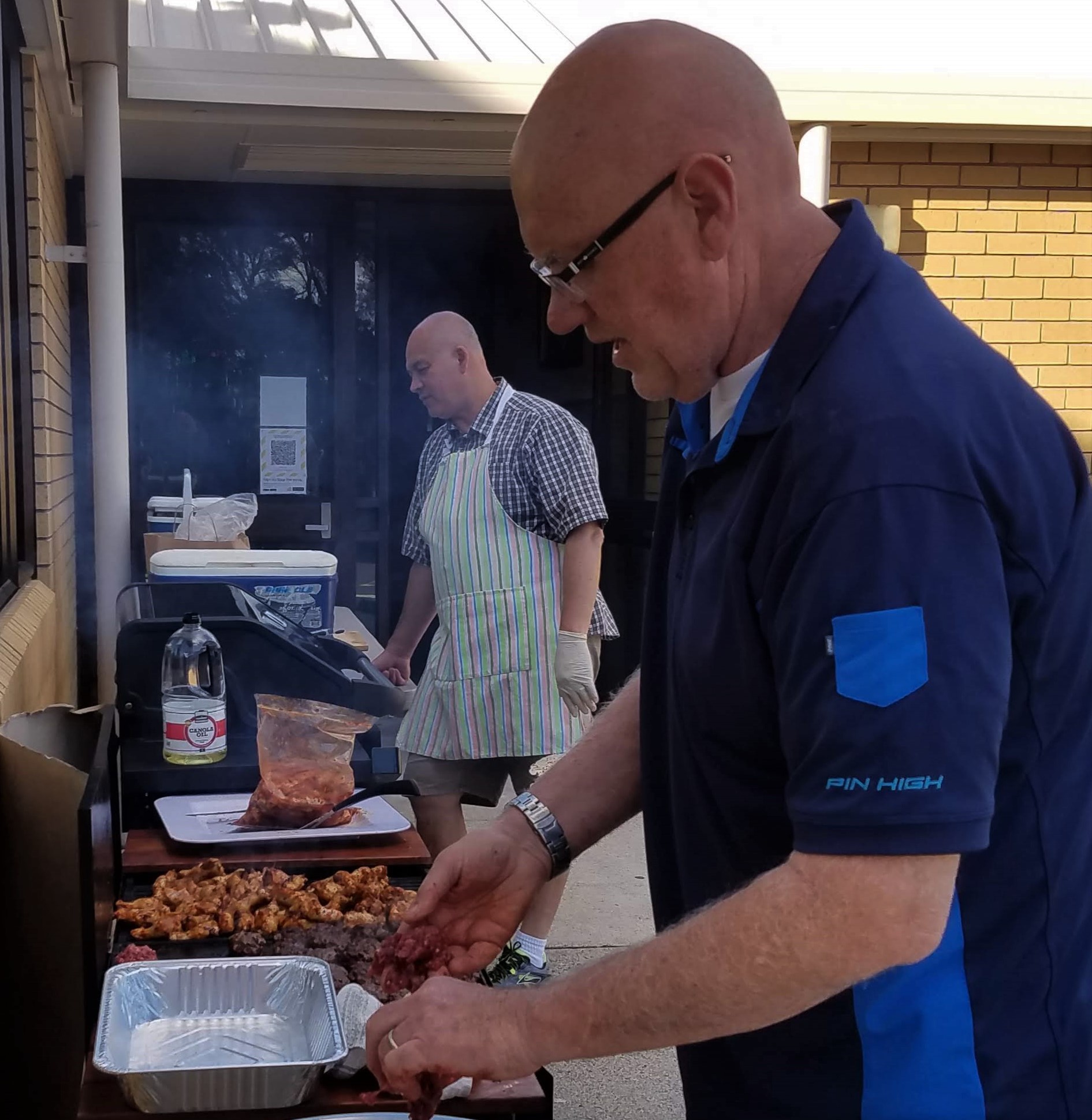
Chris and Grant manning the “barbies”
No sign-up sheets had gone around Dinsdale Ward in the weeks leading up to the party. As far as we knew, no committee had met months in advance to carefully plan the program, the menu, or the decorations. A few Sundays earlier, it had been announced that anyone who would like to do something for the program should contact a member of the bishopric. Someone must have assigned the elders quorum to cook the meat because they were the ones manning the grills, and someone had thought to bring some red ribbon to unroll down the middle of each white tablecloth, but otherwise the event seemed delightfully impromptu. Heaps of food gradually appeared on the serving tables: big trays of spicy grilled chicken nibbles, beef sliders with garlic aioli; chips (aka french fries) and kumara, sweet Maori bread and butter; not many vegetables other than the bowl of sliced cucumbers and red capsicums (bell peppers) that we had contributed. Later, during the program, the first spread was replaced with an assortment of desserts: platters laden with oranges, pineapple, strawberries, and kiwifruit; steamed pudding with custard sauce; a variety of “slices” (baked goods that occupy the space between cakes and bar cookies); little fruit tarts; and—of course—trifle and pavlova.

Dinsdale Ward’s Christmas party included a celebration for Mere B’s centennial. (She’s the one in black)
Before the program began, Dinsdale Ward took a few moments to honor its oldest member on the occasion of her 100th birthday. Mere may require some assistance to get in and out of a chair, but she doesn’t look a day over 75, and her face lights up when you ask about her experience living at the construction camp while her husband worked on the New Zealand Temple back in the 1950s. She is a living remnant of the history we’ve been researching all year, so we were glad to join in singing “Happy Birthday” to her.
Nancy and Michael opened the program with a customized version of “White Christmas” that Nancy had written for the occasion, but the remainder of the evening’s entertainment was not as Christmasy as we expected. The local kapa haka group performed part of the same set we had seen them present during a stake conference weekend in November, which was wonderful but had nothing to do with Christmas. (Kapa haka literally means “line dance” in Māori, but it’s so much more than Cotton-Eyed Joe or the Electric Slide. We’ll explain more fully in another post.) The Primary kids sang “Jingle Bells,” and then the boys did a haka (a traditional Māori ceremonial challenge dance). The theme of the latter might possibly have had something to do with responding to the unexpected appearance of shepherds or wise men from an alien tribe, but if so it was hard to tell. A mother-daughter duo wearing matching reindeer antlers did a karaoke version of “Rockin’ Around the Christmas Tree,” followed by no less than five separate Samoan dances performed by various combinations of teenage girls—and one grandmother. The accompanying music was lovely, the costumes colorful, and the dancers’ movements graceful, but we Americans were left wondering whether any of it was meant to evoke the spirit of Christmas. We missed seeing Primary children reenact the nativity story, and singing familiar carols about the Savior’s birth. What we finally realized, however, was that we were witnessing the type of exuberant community celebration that Polynesians would hold to commemorate a king’s birthday—different from our own Christmas tradition, but no less appropriate.
In addition to enjoying our Spotify Christmas playlist, we created opportunities to share uplifting Christmas music with friends and family. Michael directed the Dinsdale Ward choir in singing “Away in a Manger” and “With Wondering Awe” for sacrament meeting, and accumulated several hours at the piano in the MCPCHC theatre as he practiced a challenging solo arrangement of “O Come, O Come Emmanuel.” Sadly, both the bishop and the ward music chairman forgot that he had been asked to perform, so he never got a chance to play the piece in sacrament meeting, but he was able to share it with both our missionary cohort and our family. Stella, our youngest daughter, organized a virtual “sharing time” for our family in which we were treated to a three-year-old’s lusty rendition of “We Wish You a Merry Christmas,” some slightly halting holiday tunes performed by beginning piano students, a couple of Christmas stories involving dinosaurs and unicorns, and a display of visual art that included grandchildren’s coloring projects and daughter-in-law Amanda’s most recently completed quilt. Both Stella and Hillary (our second child) had diligently practiced new piano pieces for the occasion, and we were thrilled that daughter-in-law Emma persuaded Nat to revive his neglected keyboard skills so they could play a duet together on their new piano. We missed being able to take grandchildren on our laps and give hugs and kisses, and are sorry that we couldn’t sample the gourmet ice cream Soren (our oldest) had made, but we are grateful that Google Meet allowed us to spend an hour looking and listening and laughing together.
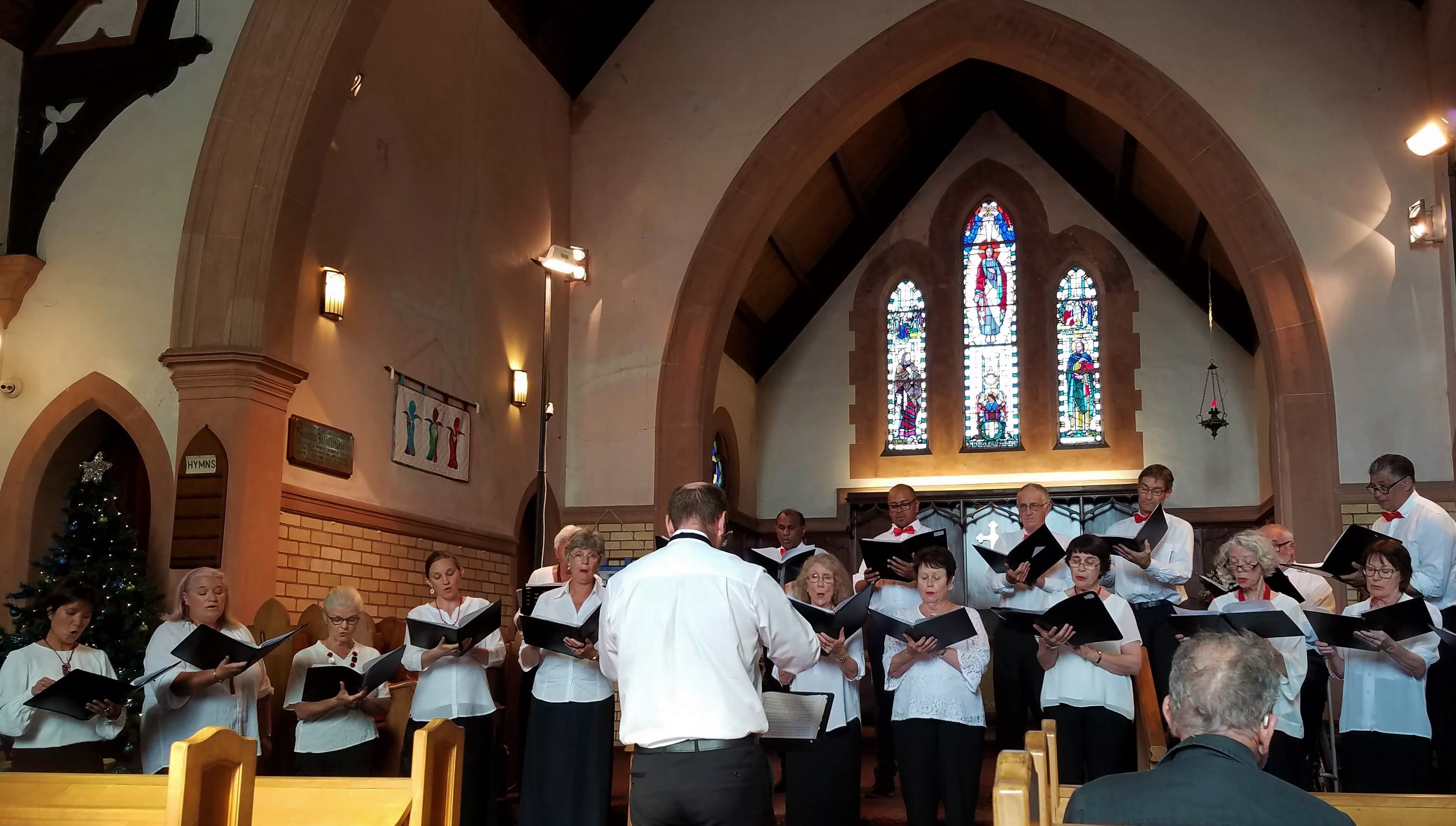
Auckland’s Handel Consort and Quire in concert
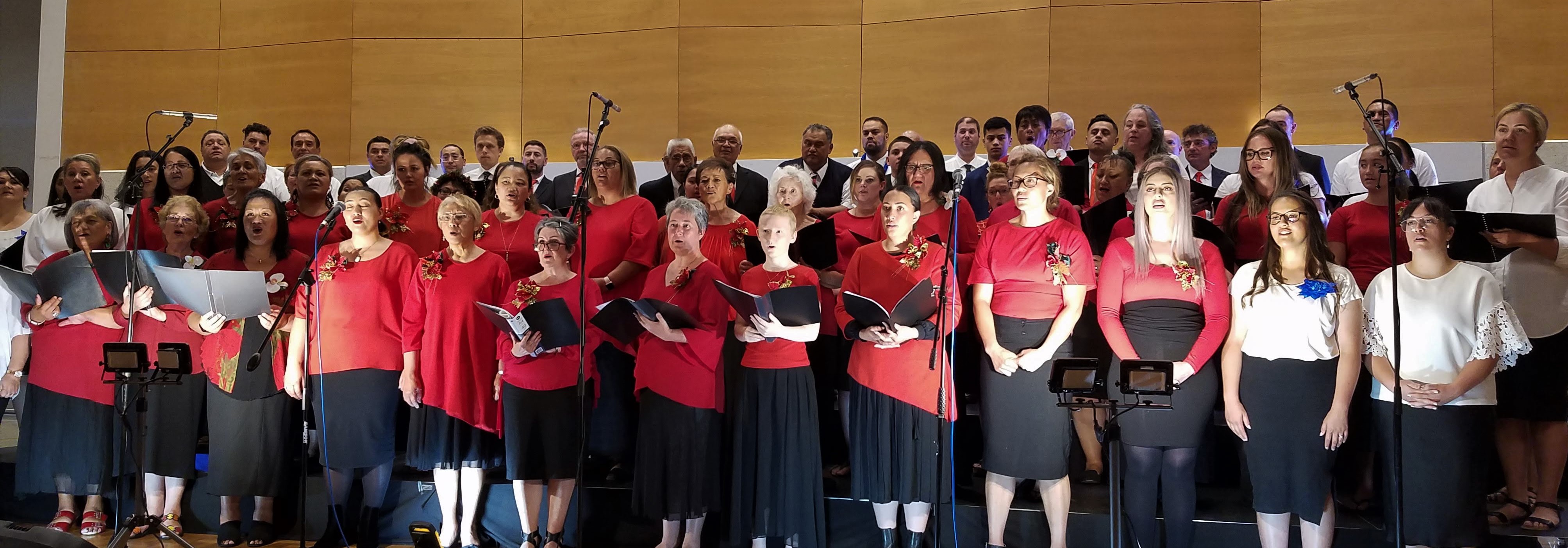
Temple View Stake Christmas concert
For Michael, the Christmas season is never complete unless he can attend a live choral concert. This year we attended two. The first was held at the David O. McKay Stake and Cultural Event Centre across the road from the MCPCHC and included items from every ward and branch in the Temple View Stake. Kiwi Latter-day Saints love their music and love to share it, performing with no inhibitions whatsoever. What was most notable about this concert (besides the penchant for uniform dress—another Kiwi tradition) was the size of each choir. It was as if every member of every ward had been persuaded to participate.
We had to drive to the Auckland area for the second live choral concert, presented by the Handel Consort and Quire at St. Andrew’s Anglican Church in Pukekohe. The group was a rung below the Cincinnati Choral Society at its lowest ebb in both size and sound: seven men and eighteen women, most with gray hair and pronounced vibrato. Although named the Handel Quire, the group did not actually sing any Handel, but rather a lot of John Rutter. Nearly everything on the program was familiar to us, so we could enjoy humming along, but the best performances of the evening came from the guest organist, a young Chinese man who made the most of the church’s robust instrument. During the interval, the audience was invited to join choir members in the social hall next door for “supper” (more like teatime). We enjoyed visiting with other concertgoers and a few choir members while we sipped our lemonade and nibbled on biscuits and little pies.
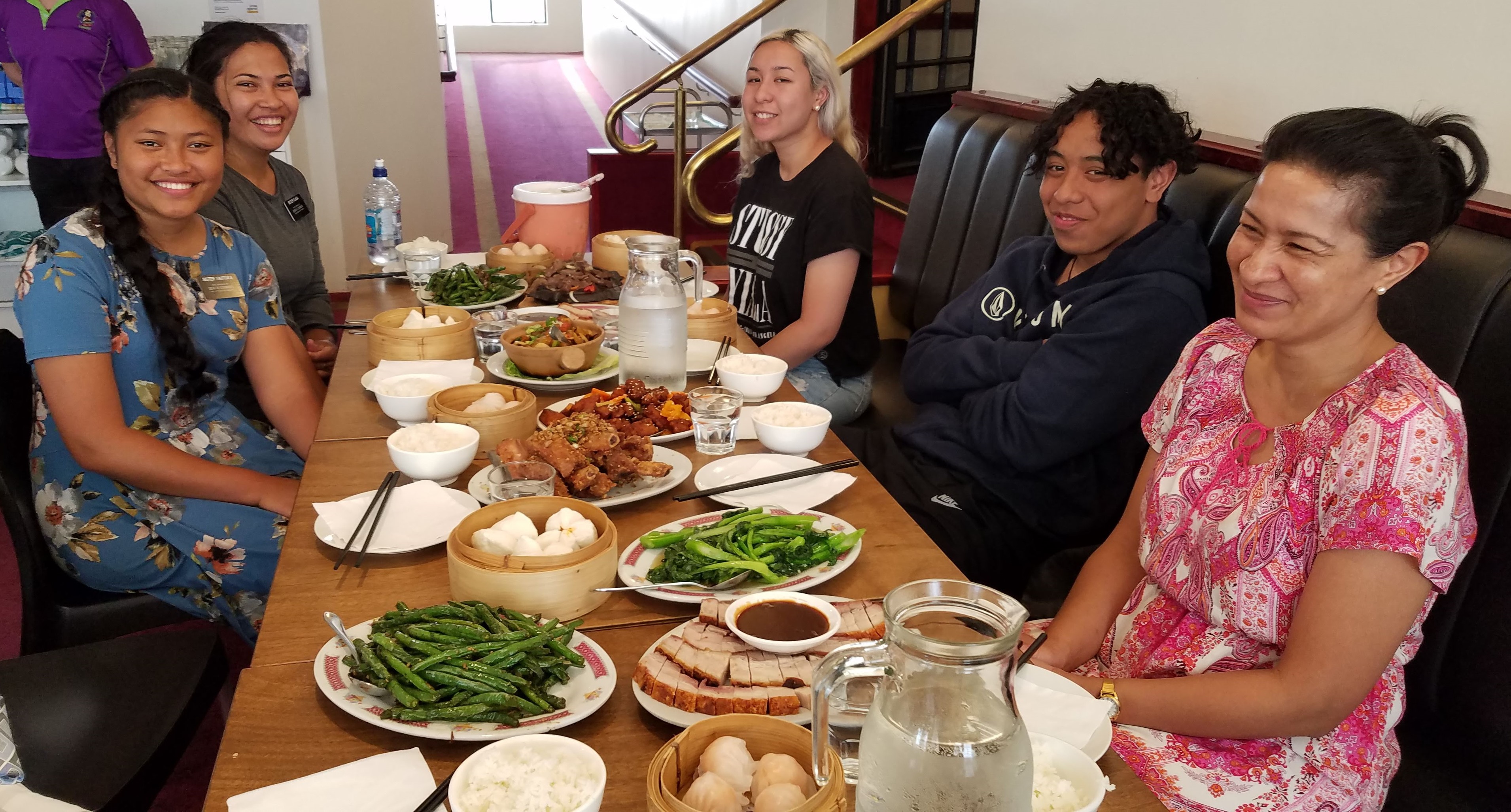
Chinese dinner with the K family at Victor’s Place
We were invited to join friends for a couple of more substantial meals in the days leading up to Christmas. Jason and Vae K, the first Dinsdale Ward members to invite us to their home for dinner, now offered to take us out to Victor’s Place, a Chinese restaurant in Hamilton that we had been wanting to try. When we arrived at the restaurant in company with the young missionary sisters who also had been invited (we picked them up because they live down the street from us), Vae, her teenage son Dallas, and her young-adult daughter Alisa were seated at a long table already laden with platters of food; they had ordered ahead so the sisters could stay within their one-hour time limit. Jason, a medical doctor who was called as our new bishop in June, arrived a few minutes later to help us consume sweet-and-sour chicken, spicy pork ribs, stir-fried beef, prawn dumplings, Szechuan green beans, and more. Michael’s favorite dish was a concoction of roast eggplant, bok choy and salted fish. We had fun talking with the bishop and his family, and trying to engage the sisters in the conversation. Neither ate very much, apparently because the Chinese cuisine was not familiar to them: one is ethnic Samoan and the other ethnic Tongan. When Nancy asked, “What favorite foods would you make for yourselves if you had time to cook and could find the right ingredients?” they seemed puzzled. “Neither of us knows how to cook,” the Samoan sister admitted, “so mostly we just eat noodles.” And neither seemed to mind that situation.
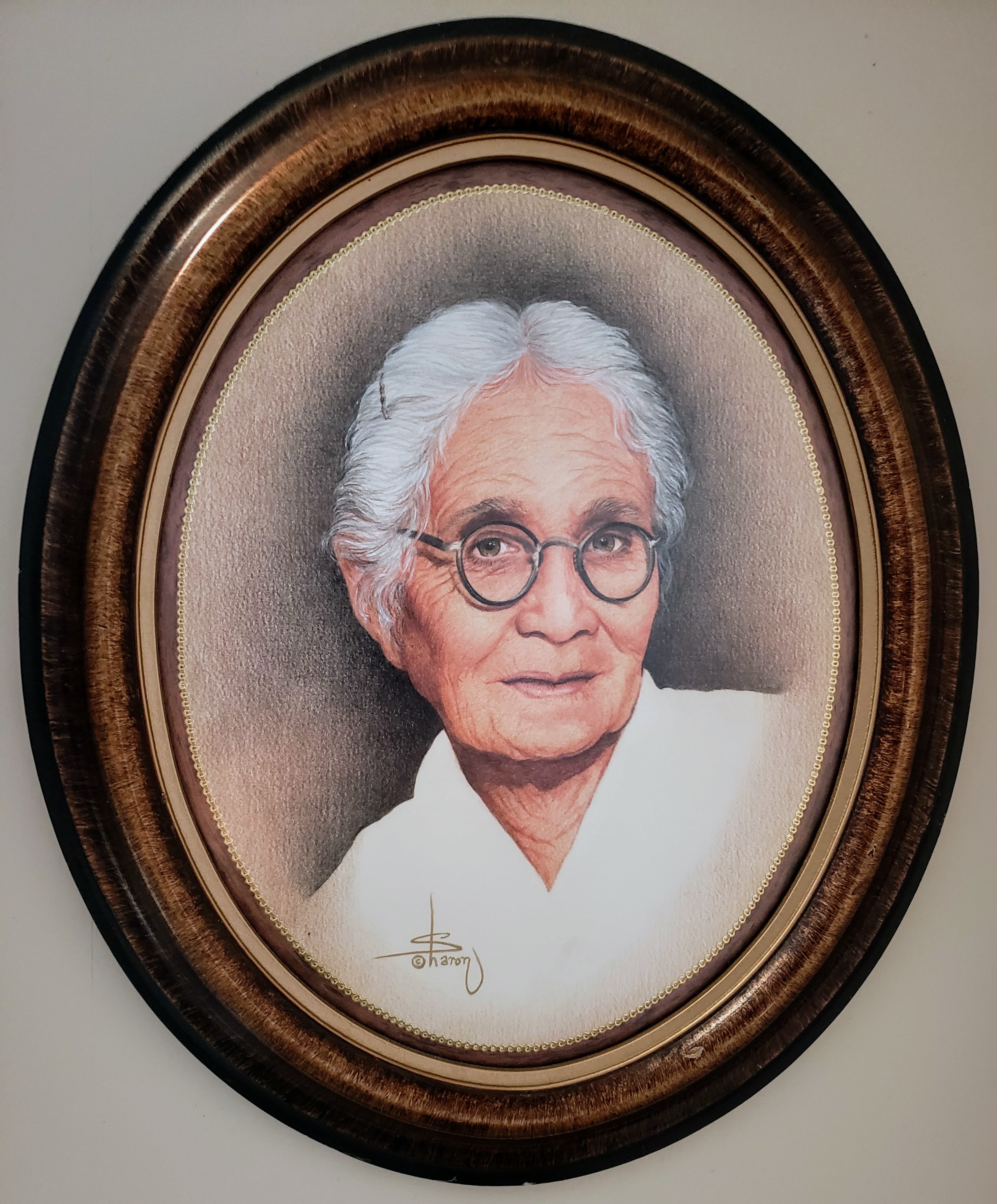
Rangi’s grandmother supervises from the dining room wall. Rangi confesses that sometimes she turns the picture around when she doesn’t want her “nan” to see what she’s doing
On Wednesday 23 December, Rangi and Vic invited the whole MCPCHC missionary cohort to their home to experience a “real Māori Christmas dinner.” Rangi left the office before noon that day so she could go home and prepare, and she wouldn’t allow anyone to help.
“My grandmother would be angry with me if I let my guests do any work,” she explained. ”She was very strict about that. When someone visits your home, you make them comfortable and take care of them. So I don’t want any of you to bring a single thing!!”
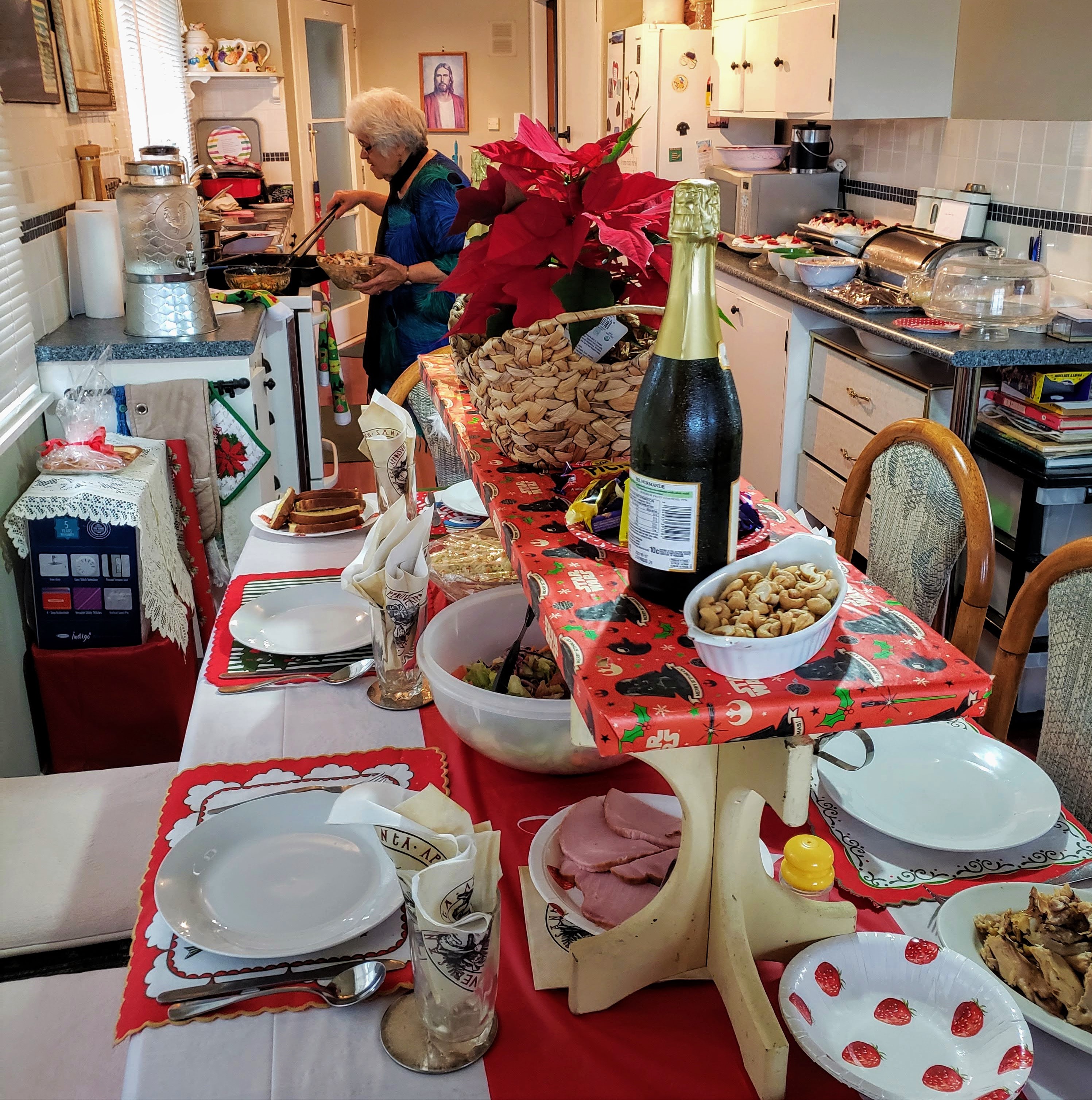
Rangi and her holiday table. Bowls of nuts and “lollies” were set among the decorations on the raised shelf in the center
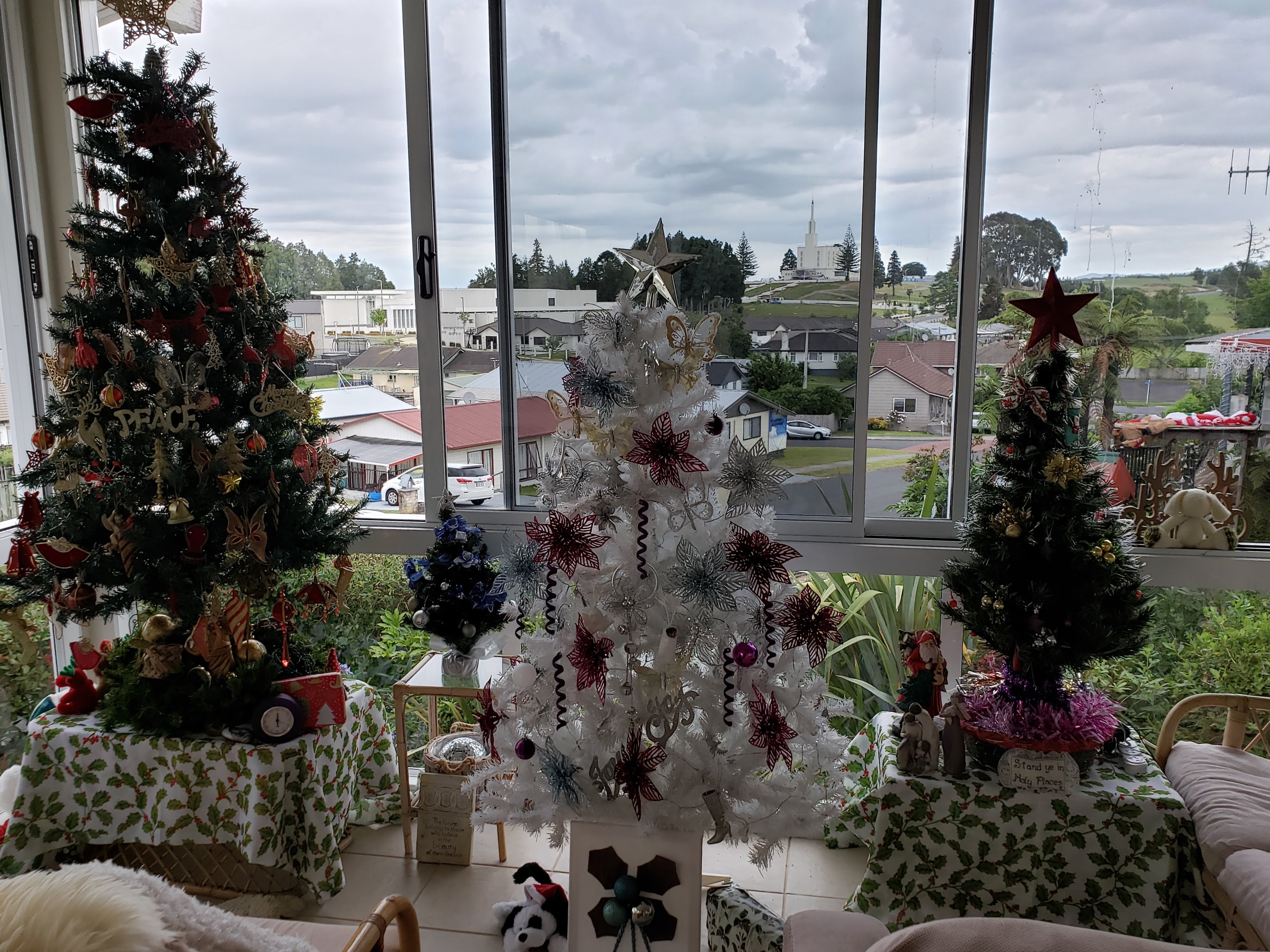
Rangi and Vic have nearly as many Christmas trees as dishes on the menu. These are in the solarium, which offers a clear view of the temple
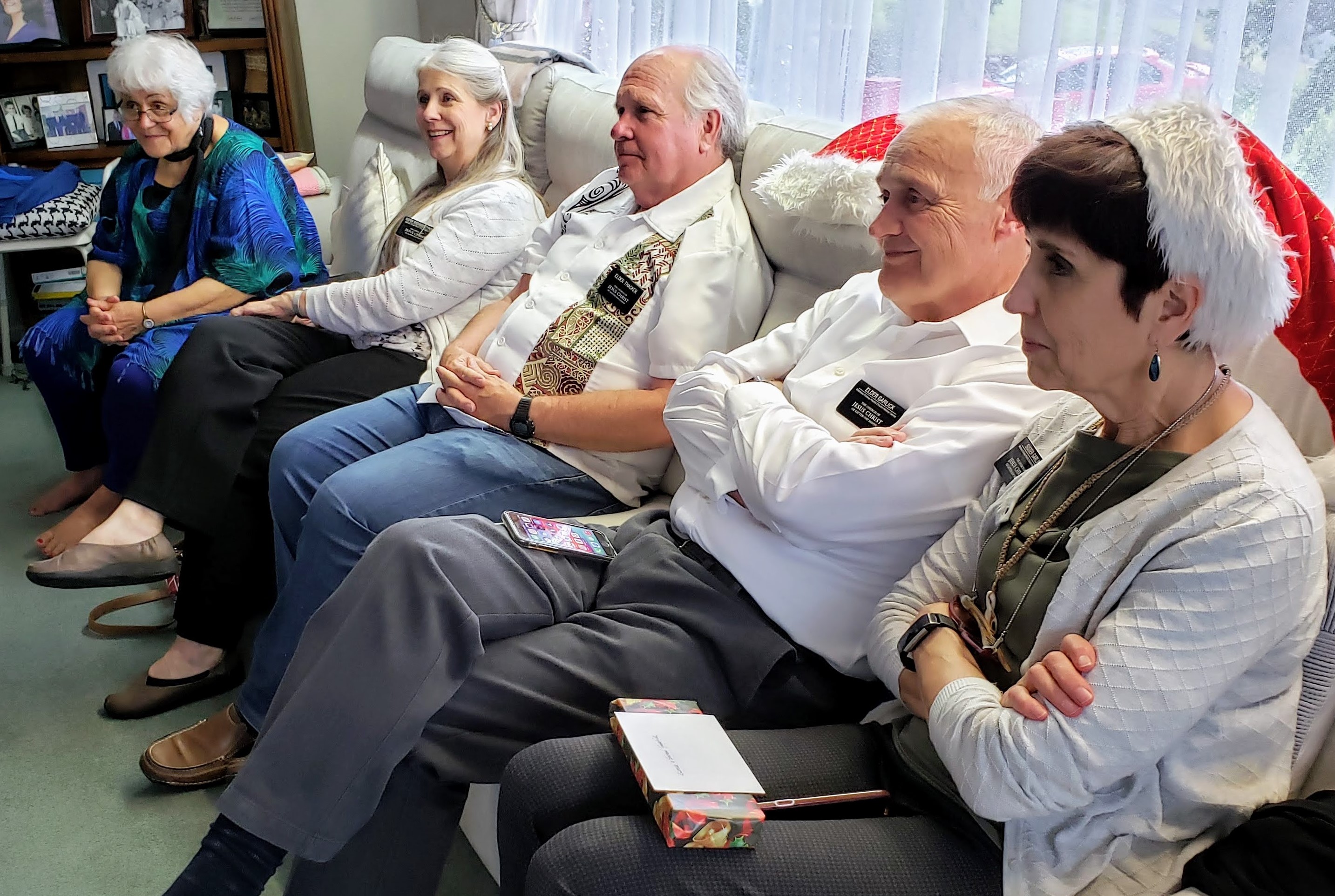
Listening to Vic (not pictured) tell a story after dinner
Rangi’s dinner menu included ham, roast chicken, roast Silverside (known in America as corned beef), roasted potatoes and kumara, Stovetop stuffing, mixed cooked vegetables, tossed salad, coleslaw, and Māori bread with copious butter.
“Save room, because I have five desserts,” she warned—although when Vic helped her bring them out, Michael counted no less than eight: pink ambrosia, steamed pudding with whipped cream, two types of pavlova, two flavors of Jell-O, and ice cream.
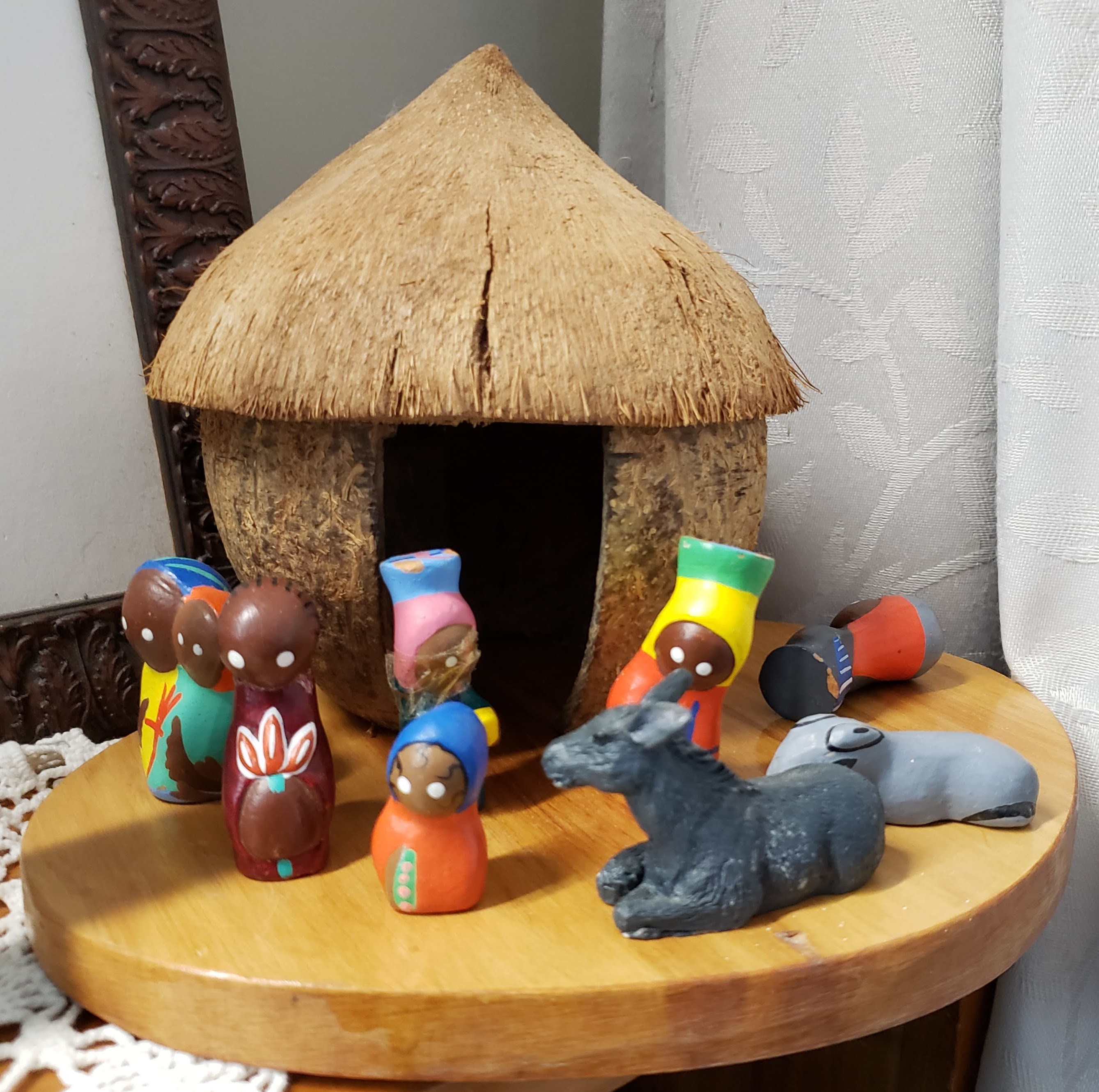
One of Rangi’s many nativities
The best thing about this “real Māori Christmas dinner” was not the food, but the loving care with which it was prepared and served. Rangi has no need to feel any disapproval from her grandmother because she and Vic are two of the most generous, loving people we’ve ever known. They truly embody the signature phrase of Matthew Cowley and the Pacific Church History Centre: Kia ngawari: Be humble, kind, gentle, and loving. Or in other words: Be Christlike. Rangi and Vic frequently remind us that they will be forever grateful to the Latter-day Saint missionaries who brought the restored gospel of Jesus Christ to the people of New Zealand. We missionaries will be forever grateful to people like Rangi and Vic who embraced that gospel, and demonstrate continued devotion to Jesus Christ in everything they do.
The 2020 Christmas season may have felt a little different from the Christmases we have experienced in the past, but the fundamentals were the same: gathering with friends and family, sharing music, joyfully serving and giving and offering thanks to God for the gift of his precious Son. We can do without snow—and even without Christmas lights—because Christ provides all the light we will ever need.

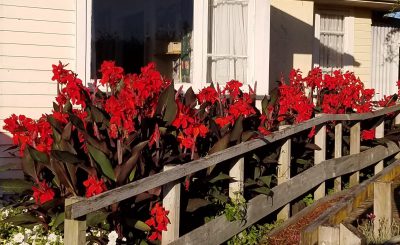

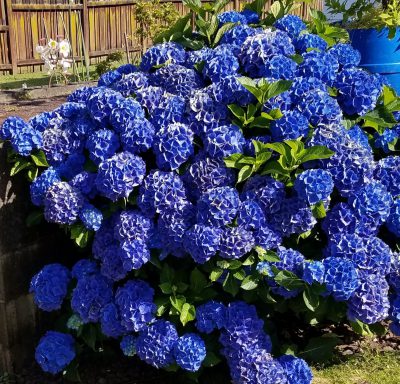
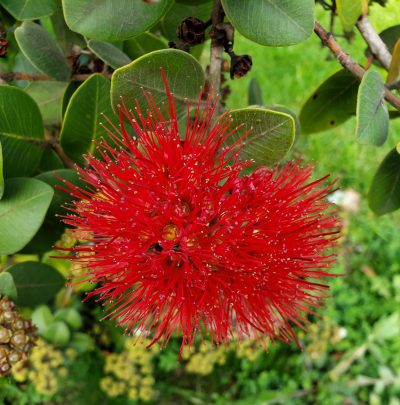
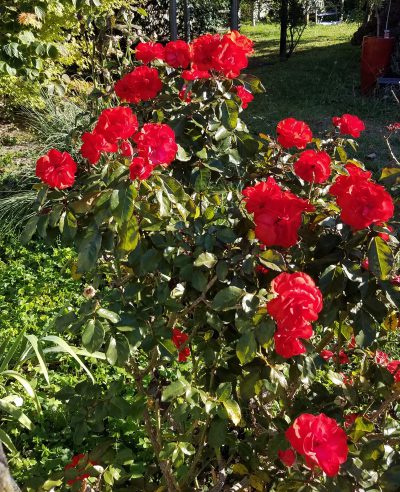
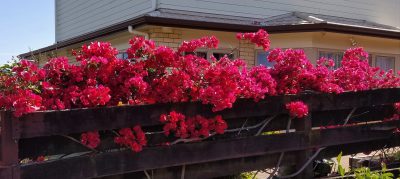
Happy merry Christmas. We have. COVID and would rather be in New Zealand.
Oh no! We’ll pray that you have a quick recovery and no lasting side effects.
Sounds like Christmas here, minus the cold; food, friends, family, music, and the Christ child. It’s 1degree outside right now so the warm sunshine sounds pretty good. So glad you were able to “see” the kids and grandkids.